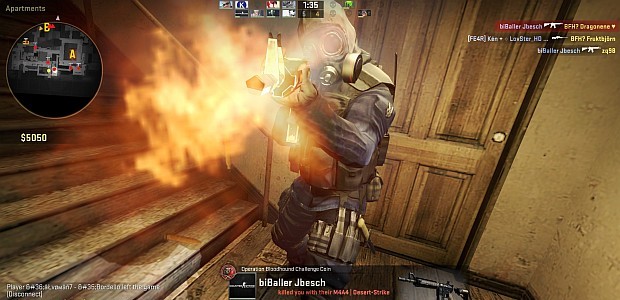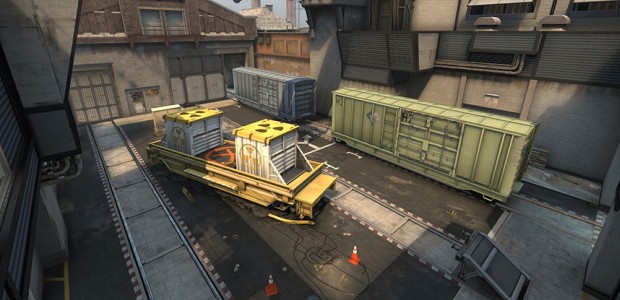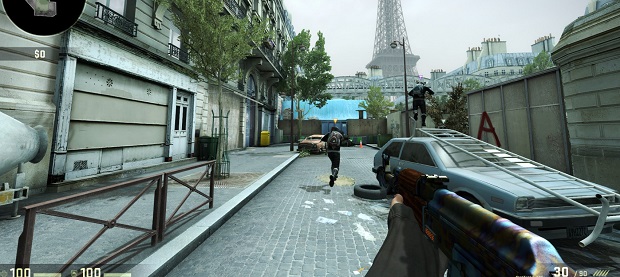
Tennis players know the peculiar feeling of zenlike calm and control that comes with starting a serve. Suddenly, all worries about footwork, planning drop shots, and recovering from an opponent s serve dissipate: the pace of the game rests in the palm of your hand.
Wielding Counter-Strike s deadliest gun is a little like that. Like a great tennis player, talented AWPers have a mixture of patience and confidence. They tap into a slow mindset and lightning reflexes simultaneously.
The AWP is an intimidator, both when it s pointed at you and when you re learning the weapon. Carrying an AWP isn t simply an equipment decision, but a discipline in and of itself with its own set of techniques, guidelines, and pitfalls.
The basics of the AWP
The AWP is heavy, powerful, and expensive. Its reputation arises from the fact that, in a game about eliminating other players from the round, it s the only weapon that can kill someone with one body shot. However, it isn t a one-hit kill in all circumstances, as leg and lower groin shots deal 85 damage (aka legging ), as do shots that clip through surfaces such as railings or corners.
With the AWP s great power comes equal responsibility. Whether in a 5-on-5 competitive game or in casual mode, you ll put down $4,750 to buy an AWP. If that investment doesn t pay off (or worse, if an opponent kills you and steals it), it can break your team s economy for rounds to come. Other than the autosniper (aka the G3SG1/SCAR-20), the same can t be said for other investments in CS:GO.
Certain aspects of the AWP make it unwieldy to the newcomer, including its effect on mobility. A player running with the knife moves at 250 units per second; with a USP-S, 240 units per second; with the AK-47, 215; with the AWP, a mere 200 units per second—20 percent slower than with a knife. Only the light machine guns, the Negev and the M249 (195 units), are slower.
The AWP s firerate is equally slow, placing huge importance on hitting your first shot. The Scout, the AWP s cheaper sibling, features a similarly slow firerate but allows for insanely high mobility, even when scoped-in (unlike the AWP). And like many of CS:GO s guns, the AWP is sensitive to movement, requiring near-perfect stillness to execute an accurate shot (see the Advanced Techniques section for more on this). AWPers are thus faced with the dilemma of holding static angles that easily fall prey to flashbangs and pincer-pushes onto bombsites.
But the AWP has more advantages still. It boasts the best penetration in-game, both in terms of wall penetration power with a value of 250 (this value ranges from 0-300, with a higher value indicating that a bullet can penetrate harder surfaces at longer distances) but also in terms of armor penetration (97.5 out of 100 in the in-game menu, the highest in the game, which in effect nullifies the damage-softening effect of armor). The right combination of guesswork and timing can lead to impossible shots that defy logic.
When should I buy an AWP?
If you want to buy an AWP in a competitive game, the best time to do it is on the first gun round of the game (typically the fourth round) and when you re carrying at least $5,750. Even if your team has lost the first three rounds, secured zero objectives, and you personally didn t notch a kill over that time, you ll have earned $6,700 total by round four, including your initial $1,000 of starter cash.
The most effective AWPer will spend even more to purchase a set of grenades, about $6,450. Here s your shopping list for a solid buy:
- AWP - $4,750
- Kevlar & helmet - $1,000
- Two flashbangs and a smoke grenade - $700
Buy an AWP without armor, and you re making a glass cannon buy. It s an enormous risk—you re turning yourself into a slow-moving cannon with no protection, not only to damage, but to the accuracy-disrupting effects of aim punch. Avoid AWPing without full armor except in the most desperate straits, like when your opponent is on the verge of winning the match.
If your teammate in competitive mode has bought an AWP, reconsider buying another one. There are situations where the map will dictate otherwise (double AWPing as CT on de_dust2 is viable due to its long sight lines on A, B, and mid), but the economic risk is rarely worth the potential gain. In casual mode on the other hand, buying an AWP is merely a matter of buying cheaply for a round or two to save up for Big Green.
The two styles of AWPing
Broadly, there are two situations in which you ll use an AWP: covering an angle while stationary (passive AWPing), or while roaming (aggressive AWPing). In the professional CS:GO scene, players like Titan s SmithZz and the Danish player nico (who was recently replaced on Dignitas) fit into the passive style, while EnVyUs kennyS or Fnatic s JW tend to play aggressively.
Passive AWPing best works at corners where you have the option of retreating behind solid cover, where you can protect yourself until the AWP is ready to fire again (e.g. the box at the back corner of B site on de_dust2). Passive players only have to worry about one angle, avoiding getting flashed or smoked out of their roost, and hitting the shot.
Passive AWPers are also the ones who have to worry the most about the maximum zoom setting when scoped-in. The AWP features two zoom settings which right clicking cycles through: one further out and a magnified one.
As a rule of thumb to the young AWP initiate, use the single-zoom setting in all of your duels. A passive AWPer holding a long position such as from bombsite A towards pit on de_dust2 should consider using the maximum zoom setting to increase chances of hitting a distant, protected target. AWPers planning on holding close angles or playing with mobility should avoid the maximum zoom setting in almost all circumstances, as it inhibits reaction to unexpected threats.
Aggressive AWPers have a much more complex portfolio to work with in terms of using the gun. For them, techniques such as walking while scoped in and searching for enemies have no place, as the maximum field of vision and information is required in order to hit lightning-fast shots. These players rely on advanced techniques of AWPing.
Learn specific AWPing techniques on the next page.
Advanced techniques
As an aggressive AWPer, you re defying some of the native characteristics of the AWP to gain map control. The aggressive AWPer needs to know when to push angles that would seem suicidal in normal scenarios and often wield their slow, clunky weapon more like a shotgun than a sniper rifle. The aggressive AWPer uses a two-handed sword as if it were a one-hander, relying on speed, intuition, and tricks to gain the advantage.
Passive AWPing can only take you so far. Think of it this way: holding an angle won t work if you meet an opponent who s quicker on the draw. Aggressive AWPers incorporate movement and manipulative model tricks (peeking at certain angles crouched or with a varying speed) to defeat their opponents.
Crouch-peeking and shoulder-peeking relies on the inherent advantage that comes with peeking in CS:GO (check this GIF below for a visual representation) by turning corners quickly, scoping in, and firing with a little bit of guesswork. Although some of this technique relies on popping out at an unexpected place or time, it s also underpinned by two mechanics of the game itself. AWPers use corner advantage, the Source engine s preference for the camera to be slightly left-of-center, allowing them to see an opponent just a moment before they see you.
To shoulder-peek, you should quickly strafe a corner or known angle with a shot in mind, scope-in and automatically fire, and strafe back in the opposite direction right away; all of this should be one fluid motion with no delay except to stop and quickly shoot. This technique tries to limit the chances of being prefired or tagged, and keeps you mobile as an AWPer.
Crouch-peeking adds one more element to this act of angle manipulation, by bringing the player into a crouched-state as they round a corner. This is meant to throw off a defensive player whose crosshair, if they re experienced, is most likely aimed at head height. To crouch-peek, hold the crouch key as you round a corner, falling into your aim in one motion. In the brief moment that you re stationary, you should be crouched, scoped-in, and aiming at an angle that you are looking to clear. Chances are the opponent is trying to correct his aim and you ve got a clear shot!
Aggressive AWPers have to master this quick input of keys: crouch, strafe, scope-in, and fire, without doing any of these commands too quickly or else the recoil is thrown off. The crouch key needs to be pressed exactly as the player rounds the corner, and not before or after.
Quickscoping is a technique where right-clicking is immediately followed by a left click, granting a more accurate shot than you would have by noscoping. To try a quickscope, stop moving, then right and then left click in rapid succession. Practice this technique in casual play so you ll have more opportunities to buy the AWP and less pressure to contribute to a victory.
Noscoping, or the art of using the AWP like it s the world s largest pistol, is still functional and sees occasional use by pro players in the highest echelon of CS:GO. Noscoping is often the best and only choice when someone is rushing you head-on. If you find yourself in this situation, dip your aim to around center of mass on an enemy, stop moving as much as possible before you shoot, trust your muscle memory, and wait until the last possible moment to fire to maximize the angle and distance between you and your target s hitboxes.
Wallbanging is Counter-Strike s tasteful way of referring to shooting through hard map surfaces. There are certain angles that only an AWP (or an autosniper as well) can penetrate and several of these happen to be in very useful positions. As seen in these clips on de_cache, preset angles can be used to try and tag players on the other side of the map. The best way to try this yourself is to load a map on an offline server (simply type map de_dust2 in console, for example), then enter sv_showimpacts 1 in the console to track bullet penetration and search for new spots.
Lastly, and very infrequently, the AWP is able to hit accurate shots at the apex of a jump, similar to the notorious Scout jumpshot but far less dependable and requiring near perfect timing. Rarely seen, this technique is best left to hyper-aggressive players willing to take the risk.
 PC Gamer Pro is a new channel dedicated to esports and competitive gaming. Check back every day for exciting, fun and informative articles about League of Legends, Dota 2, Hearthstone, CS:GO and more. GL HF!
PC Gamer Pro is a new channel dedicated to esports and competitive gaming. Check back every day for exciting, fun and informative articles about League of Legends, Dota 2, Hearthstone, CS:GO and more. GL HF!









